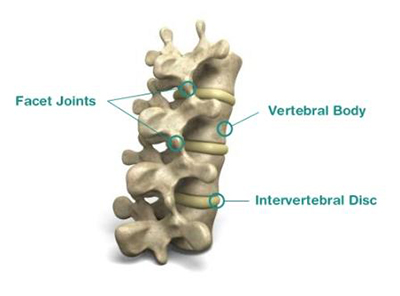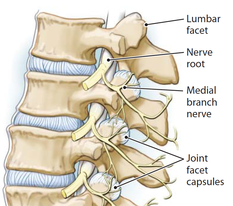What is
Facet Joint Pain
Facet joints are paired spinal joints found on the posterior aspect of the spine. There is one joint on each side of the spine at each cervical, thoracic, and lumbar level. These joints, along with spinal disks, help provide support and mobility during movement and each spinal vertebral level. These joints are like other joints in the body with joint cartilage and lubricating joint fluid called synovial fluid produced by a joint lining called the synovium. Facet joints have the same tissues as knees and hips.
What are the Symptoms and Causes of Facet Joint Pain?
Cervical facet joint pain can result in neck pain with radiation into shoulder or shoulder blade area, and/or headache. Neck stiffness and muscle tenderness is also common. It is also common to experience sensations or sounds often described by patients as ‘grinding’, ‘popping’, ‘cracking’, ‘gravel’, or ‘sand paper’ in the neck or back. Thoracic facet joint pain can cause middle back pain, usually, at the level of the shoulder blades or below. Lumbar facet joint pain can cause low back pain with radiation into the buttock, hip, or thigh. These neck and back pain symptoms are usually worse in the morning and improve within a few second to minutes after walking around and limbering up. The symptoms are also often worsened by prolonged sitting or standing and make standing upright out of a chair difficult, and again, typically improves with movement. Most patients will have spinal tenderness overlying the affected areas. Pain is often aggravated by leaning back (extension) and/or twisting (rotation) of the neck or back, and can be relieved by bending forward (flexion). Cervical facet pain can cause pain when turning the head while driving or difficulty at night relaxing the neck when lying down. Lumbar facet pain can also cause difficulty lying flat on ones back. If the arthritis is causing a pinched nerve or spinal stenosis symptoms can include arm or leg pain, numbness, tingling, or muscle weakness.

How do you Describe Facet Joint Pain?


The facet joints help support weight-bearing and control movement between vertebrae of the spine. There are two facet joints (one on each side) at each spinal segment. These joints may degenerate. Degenerative joint changes are common in the older population, but may occur in younger adults, particularly with prior trauma.
Facet joint pain is spinal pain related to these joints in the cervical, thoracic, or lumbar spine. These pains are usually described as an ache or stiffness feeling and after often associated with spine muscle tenderness and stiffness. Symptoms can come and go. At times the symptoms are minimal but can flare with more moderate to severe activity . Severe incapacitating pain is not typical of facet pain. In more advanced cases of facet arthritis, bone spurs can form and/or the joints enlarge and pinch spinal nerves or the spinal cord and cause cause radicular pain or spinal stenosis symptoms. including Myelopathy, or injury to the spinal cord, can occur if the joints in the neck or thoracic area enlarge enough to compress the spinal cord itself.
As with other joints in the body, osteoarthritis (“wear and tear”) is the most common cause of this painful joint condition. Other conditions such as rheumatoid arthritis, ankylosing spondylitis, trauma or whiplash, and stresses related to degenerative disk disease, scoliosis, or prior back surgery can also contribute to spinal joint pain. In these conditions, inflammation and pain in the facets is most common in older populations as a degenerative process, but can also occur in younger people, particularly if there is a history of prior spine trauma including fracture or whiplash.
The initial step of treatment is conservative care consisting of activity modification, stretching, physical therapy, chiropractic manipulation, and/or medications. Physical therapy consists of both active and passive treatments. These treatments are utilized to restore or improve spinal range of motion and muscle function. Physical therapy, an active treatment, consists of stretching and strengthening exercise activities. Exercise is utilized improve strength of the supporting spinal muscles and restore normal spinal posture and range of motion. Passive treatment can include such things as ice, muscles rubs, electrical stimulation, ultrasound, traction, massage, and chiropractic manipulation which are used to relieve muscle tension and pain caused by the underlying joint pain. Next, if symptoms persist, diagnostic facet injections can be performed to the facets to block pain at the joint area. If the procedure is successful in producing temporary pain relief the joint is confirmed as a cause of back pain. Finally, a rhizotomy (also called radiofrequency ablation or neurotomy) can be performed in an attempt to provide longer lasting pain relief ranging from months to years, typically 6-18 months. Longer term, it is recommended that people stay physically active and participate in a daily exercise program in order to maintain spinal function and promote a healthy lifestyle.
What are the Treatment Options for Facet Joint Pain?

Request An APPOITMENT
Fell free to contact us with any questions or concern regarding Back/Neck pain.